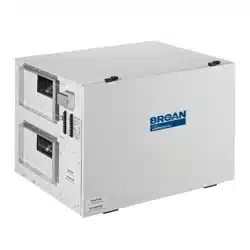Loading ...
Loading ...
Loading ...

6
3. Controls
3.1 General Information
FAN INTERLOCK RELAY OUTPUT (FF)
External fan control can be achieved by connecting an external 24 volts fan control through dry contacts (FF). These contacts are closed
on a call for ventilation or defrost. See wiring diagram shown in Appendix E.
SPEED SELECTION
There are three speed settings available with the controls, only two of which can be functional at any one time. The units are factory set
to use the low and high speed taps on the blower motors. If necessary, the medium speed tap can be used instead of the low speed
tap. See wiring diagrams for instructions on how to make this change. Units without the remote wall control option can be shut off by
opening the contact between LOW - COM or HIGH - COM as shown in Appendix E-2.
3.2 Sequence of Operation
Before start-up, check the unit for obstructive packaging, objects near or in blowers, dampers, heat exchangers, etc. Once installation
is complete, check all modes of operation to ensure that the unit is working properly. Close the doors and check for operation on LOW,
COM and HIGH. Use a wall control or the dry contact switching to run fan speeds as shown in Appendix E-2.
UNIT CHECK POINTS (ALL UNITS):
• Power connected, no ventilation call - Both fans are off, defrost damper (if equipped) closes off fresh air from outdoors.
• Power connected, low speed call - Both fans on low speed internal defrost damper (if equipped) opens fresh air from outdoors. If the
unit is equipped with recirculation module, the internal defrost damper closes recirculation opening.
• Power connected, high speed call - Both fans on high speed, defrost damper opens fresh air from outside. If the unit is equipped
with recirculation module, the internal defrost damper closes recirculation opening.
• Power connected, occupied timer/sensor connection open (unoccupied mode) - Both fans are off, defrost damper closes fresh air
from outdoors. If the unit is equipped with recirculation module, the internal defrost damper opens recirculation opening.
• Power connected, FF control contacts close during unit ventilation or defrost cycle.
3.3 Defrost
The unit functions are controlled by integrated controls in the unit which may include Exhaust Only Defrost or Recirculation Defrost (via
the recirculation module). In cold temperatures, defrost cycles will remove frost from the heat recovery core to maintain good operation.
EXHAUST ONLY DEFROST (OPTIONAL)
Frost removal occurs when the supply blower de-energizes, the supply air damper and the core damper close and the exhaust fan
continues to circulate only warm inside air through the heat recovery core or energy recovery core to maintain ventilation. This process
prevents the build up of ice in the core. Defrost is temperature initiated at 23°F to -22°F (-5°C to -30°C) and time based.
RECIRCULATION DEFROST MODULE (OPTIONAL - FACTORY INSTALLED)
The defrost cycle is electronically controlled in response to the outdoors temperature 23°F to -22°F (-5°C to -30°C). On a call for defrost,
the supply air damper in the recirculation module closes, exhaust fan is de-energized and the supply fan continues to recirculate warm air
through the heat recovery core or energy recovery core. It is possible to extend the defrost times during very cold weather by removing
the jumper JU1-F on the circuit board as shown in Appendix F. For dimension and weight changes to the B6LC and B12LC models with
recirculation defrost, see Appendix B-2 and B-4.
3.4 Remote Wall Control (Optional)
Remote mounted wall control options can be used to control the ventilators from a location remote to the installed unit location. The
connection from the ventilator to the control is low voltage and requires a 4 conductor (24 ga. minimum) LVT cable. Models are available
with a dehumidistat control. The following option is available.
S
LIDE SWITCH TYPE
Dehumidistat to engage high speed exchange. Slide switch operation supporting continuous low exchange and continuous high
exchange.
WARNING
!
A negative building pressure may develop during the defrost cycle with possible back drafting fumes from
combustion equipment, which may have severe health consequences.
Loading ...
Loading ...
Loading ...
